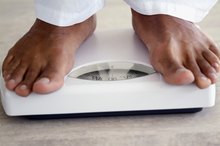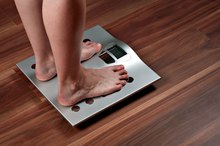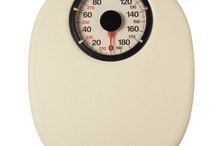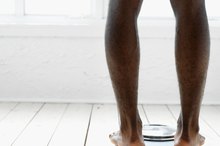How to Lose Weight When You Weigh 400 Pounds
At 400 pounds you will be classified as morbidly obese. Losing weight will not only greatly improve your appearance but it could also save your life. According to the U.S. National Library of Medicine, being obese massively increases your chances of developing diabetes, heart disease, arthritis and some cancers, and puts you at a certainty of premature death. However, just losing 5 to 10 percent of your body weight can reduce these risks. The trouble many obese people face is a series of previous unsuccessful weight-loss attempts. The key to losing weight when you're 400 pounds is consistency and making small changes.
Reduce your daily calorie intake by 500 to 1,000. A calorie deficit, where you consume fewer calories than you burn, is vital for losing weight. A healthy, sustainable rate of weight loss is 1 to 2 pounds per week, claims MayoClinic.com. To lose 1 pound of fat requires a deficit of 3,500 calories, so cutting 500 calories each day will lead to a loss of 1 pound per week, while cutting 1,000 calories per day will result in a 2 pound per week loss. The Mayo Clinic adds that obese people can go on very-low-calorie diets for rapid weight loss, but these require constant medical supervision.
How Fast Can a 250-Pound Person Lose 10 Pounds?
Learn More
Make healthier choices at mealtimes and choose lower calorie snacks. Cutting calories doesn't have to be difficult -- simply switch from high-sugar, high-fat foods to healthier ones. Base your main meals around lean protein such as meat, fish and low-fat dairy products, fresh fruits and vegetables and whole grains. For snacks, choose more fruit and veggies, small portions of nuts and seeds, or low-calorie, high-fiber foods such as brown rice cakes or whole-wheat crackers.
Introduce exercise into your daily routine. You don't have to train intensely to start with -- just get moving. The American College of Sports Medicine recommends participating in simple activities that have little impact on your joints, such as walking, swimming or cycling. Spend five minutes warming up, then go at a comfortable pace for as long as you can manage and spend five to 10 minutes cooling down and stretching. Focus on increasing the duration of your sessions before upping the intensity.
How to Write a Time Plan for Foods & Nutrition
Learn More
Set small, regular goals to keep yourself on track. Staying mentally focused can often be challenging, and it's easy to relapse into old ways. Aim to set one behavioral goal and one outcome goal each week. Your behavioral goal could be to eat at least five portions of vegetables per day, avoid candy for a week or train on at least three days. Your outcome goals should be results based, such as losing 2 pounds by the end of the week or complete a walking or cycling route five minutes quicker.
Tips
Enlist the help of a qualified trainer when starting out at the gym to make sure you're using the equipment in the correct manner and performing exercises with proper technique.
Warnings
Check with your health-care provider before beginning a diet and exercise regime and consult with them regularly during the process.
Related Articles
References
Writer Bio
Mike Samuels started writing for his own fitness website and local publications in 2008. He graduated from Peter Symonds College in the UK with A Levels in law, business and sports science, and is a fully qualified personal trainer, sports massage therapist and corrective exercise specialist with accreditations from Premier Global International.








